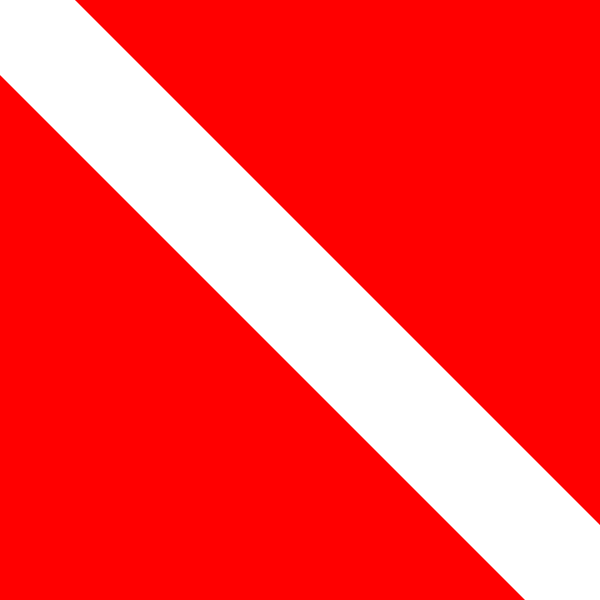 You must have seen this little flag. In each boat diving is definitely attached flag. Now the picture is actually installed in the central office or at the dive services workers diving uniforms. If you are a fan of rock music Van Halen, in 1982 this band uses this logo on the cover of their album titled Diver Down.
You must have seen this little flag. In each boat diving is definitely attached flag. Now the picture is actually installed in the central office or at the dive services workers diving uniforms. If you are a fan of rock music Van Halen, in 1982 this band uses this logo on the cover of their album titled Diver Down.What is the diving flag? Here's the explanation:
A diver down flag, or scuba flag, is a flag used on the water to indicate that there is a diver below. In North America it is conventionally red with a white stripe from the upper left corner to the lower right corner. Internationally, the code flag alfa/alpha, which is white and blue, is used to signal that the vessel has a diver down and other vessels should keep well clear at slow speed.
Purpose
The purpose of the flags is to notify to any other boats to steer clear for the safety of the diver and to avert the possibility of a collision with the dive boat which may be unable maneuver out of the way.
The use of the red and white flag, which was designed and introduced in 1956 by Navy veteran Denzel James Dockery, is required by law or regulation in many US states and Canada, as well in several other countries in the world (e.g. Italy). Usually the regulations require divers to display the flag and to stay within a specified distance of it when they are near the surface. As well there is often a larger zone around the flag where no boats are allowed to pass. Some states also prohibit the display of this flag when there is no diver in water. It can be placed on a boat or on a surface marker buoy.
Signal flag ALFA/ALPHA
 As a code signal the International maritime signal flags A (letter ALFA/ALPHA) has the meaning of "I have a diver down; keep well clear at slow speed", used to indicate the presence of a diver in the water, and is more commonly employed in Europe and the British Commonwealth, including countries such as United Kingdom, Ireland, Australia, Canada, New Zealand, South Africa, and Kenya. It is also used by Russian Navy for the same purpose.
As a code signal the International maritime signal flags A (letter ALFA/ALPHA) has the meaning of "I have a diver down; keep well clear at slow speed", used to indicate the presence of a diver in the water, and is more commonly employed in Europe and the British Commonwealth, including countries such as United Kingdom, Ireland, Australia, Canada, New Zealand, South Africa, and Kenya. It is also used by Russian Navy for the same purpose.A rigid replica of the 'A' flag is required to be displayed by any vessel engaged in diving operations, when restricted in her ability to maneuver, if the size of the vessel makes it impractical to display the shapes and lights required by the International Rules for Prevention of Collisions at Sea (IRPCS) Rule 27.Although the presence of the 'A' flag may afford some protection for divers in the vicinity of the vessel displaying the flag, the intention of the rigid replica required by IRPCS Rule 27 (e) is to warn other vessels of the danger of collision. This marks a distinction between the 'A' flag and the red and white diver down flag
Other Use
Today the red and white flag is so strictly associated with scuba diving
that it is also used to indicate a place where there are services for
divers, for example stores selling or renting diving equipment or scuba
service stations. It may be seen on the windows or bumpers of cars
belonging to divers.

No comments:
Post a Comment